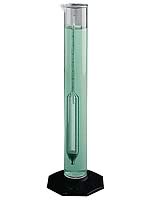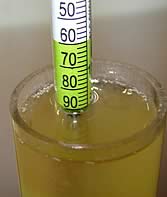Hydrometer Instructions
A hydrometer is not complicated to use. Follow these easy steps and you'll be taking readings like a pro.

Take a sample of wine
You'll need about a half cup of wine. You can use a wine thief that fits into the narrow neck of your carboy to take this sample. You will also need a testing jar or cylinder to transfer the sample to. Make sure you put enough wine into the jar so that your hdrometer floats when placed in the jar. Give the jar a tap on a table top to force out gas that may be collecting on the sides. Put your testing jar at eye level so you can get an accurate view.

Take your reading
Place your hydometer in the sample and give it a spin. When the hydrometer settles view across the top of the liquid. Your reading is the point where the surface of the liquid meets your hydrometer. At this meeting point you will take the reading from the scale on your hydrometer. You'll usually want to take a gravity reading at the beginning of fermentation and another at the end. A typical beginning gravity for wine is 1.085 and it will finish at about 0.990.

Temperature correction
Hydrometers are calibrated to be accurate at a certain temperature—usually 15° Celsius—however some hydrometers are calibrated for different temperatures so it's best to check your hydrometer. The calibrated temperature will be list on the bottom of the hydromter. If the temperature of your juice is different from the calibrated temperature you will need to make an adjustment calculation. Most hydrometers come with a conversion chart or you can use one of the many calculators found on the web. Google "hydrometer temperature correction" and you'll find calculators where you can put in the temperature of your juice and it will calculate and give you the results.
